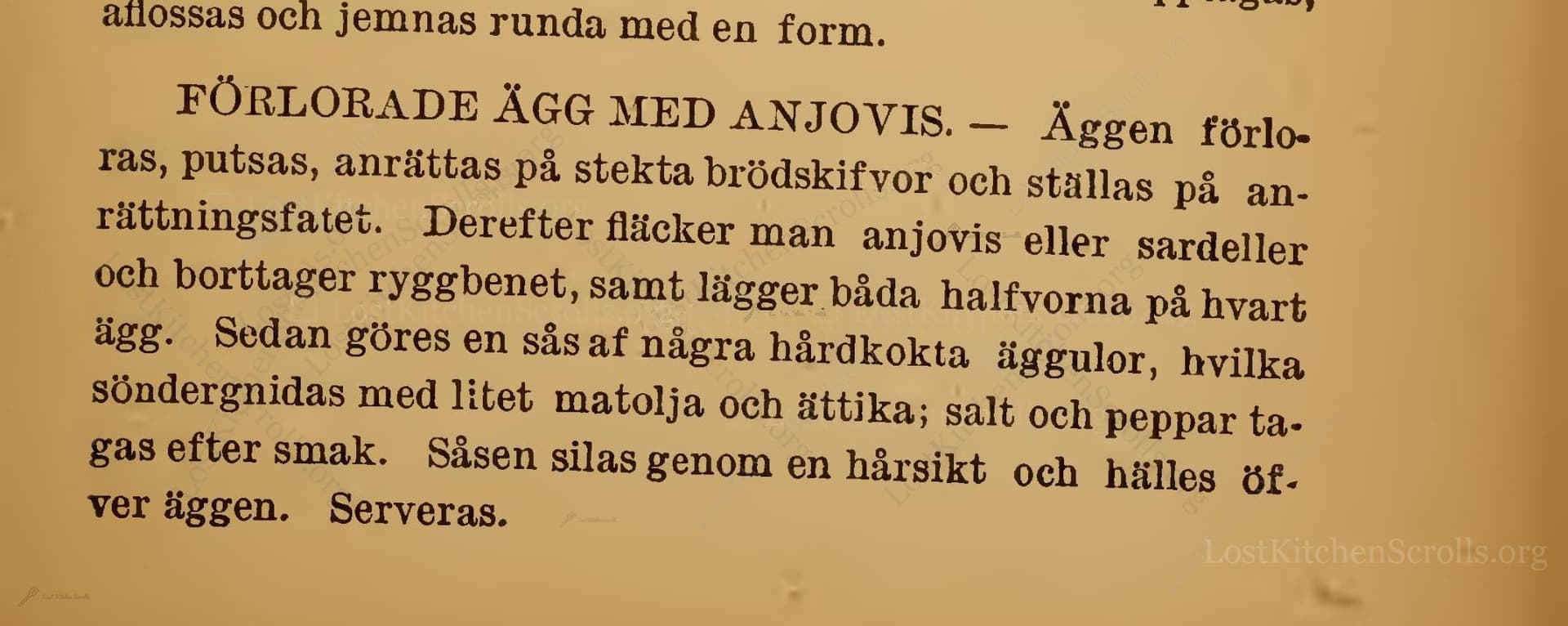Förlorade Ägg Med Anjovis
"Lost Eggs With Anchovy"
From the treasured pages of Praktisk, illustrerad kok-bok för Svenskarne i Amerika
Written by C. A. (Charles A.) Vallentin

Förlorade Ägg Med Anjovis
"Äggen förloras, putsas, anrättas på stekta brödskifvor och ställas på anrättningsfatet. Derefter fläcker man anjovis eller sardeller och borttager ryggbenet, samt lägger båda halfvorna på hvart ägg. Sedan göres en sås af några hårdkokta äggulor, hvilka söndergnidas med litet matolja och ättika; salt och peppar tagas efter smak. Såsen silas genom en hårsikt och hälles öfver äggen. Serveras."
English Translation
"The eggs are poached, trimmed, arranged on fried slices of bread and placed on a serving dish. Then anchovies or sardines are split and the backbone removed, and both halves are placed on each egg. Next, a sauce is made from some hard-boiled egg yolks, which are mashed with a little cooking oil and vinegar; salt and pepper are added to taste. The sauce is strained through a fine sieve and poured over the eggs. Serve."
Note on the Original Text
The recipe is written with an economy of instruction, assuming familiarity with basic culinary preparations like egg-poaching and bread-frying. Precise measurements are absent; cooks were expected to rely on judgment and taste, in line with the intuitive domestic cooking of the late 1800s. Spelling like 'putsas' (trim), 'anrättas' (arrange), and 'hälft' (half) reflects older Swedish orthography, and words like 'förlorade' refer specifically to poaching (literally ‘lost’ eggs). The sequence of assembly—a hallmark of Scandinavian foodways—ensures visual appeal and balanced flavors.

Title
Praktisk, illustrerad kok-bok för Svenskarne i Amerika (1889)
You can also click the book image above to peruse the original tome
Writer
C. A. (Charles A.) Vallentin
Era
1889
Publisher
Svenska bok-och musikhandelns förlag
Background
A practical and charmingly illustrated Swedish cookbook tailored for immigrants in America, this 1889 volume serves up a delightful array of recipes and culinary wisdom, blending Old World tradition with New World ingredients.
Kindly made available by
Library of Congress
This recipe hails from 'Praktisk, illustrerad kok-bok för Svenskarne i Amerika', published in 1889 in Minneapolis for Swedish immigrants seeking both comfort and familiarity in their new American homes. It reflects the adaptation of classic Swedish flavors—eggs, anchovies, and hearty bread—using ingredients accessible in America at the time. Eggs cooked 'förlorade', or poached, were a cherished dish in 19th-century Sweden, and serving them with anchovies or sardines layered over sturdy toast hearkens to both frugality and festive presentation. The tangy sauce of egg yolk, oil, and vinegar rounds out a dish designed to feel both nourishing and celebratory.

In a late 19th-century kitchen, one would use a cast iron frying pan to crisp the bread and a deep saucepan for gently poaching the eggs, likely over a wood-burning stove. Fine kitchen knives would be needed to fillet the anchovies or sardines and remove the backbone neatly. To create the sauce, a sturdy ceramic mortar and pestle or the back of a spoon could be used to mash the yolks, while passing the finished sauce through a hair sieve (hårsikt) ensured silky texture—an essential detail in finer cooking of this era.
Prep Time
10 mins
Cook Time
15 mins
Servings
4
We've done our best to adapt this historical recipe for modern kitchens, but some details may still need refinement. We warmly welcome feedback from fellow cooks and culinary historians — your insights support the entire community!
Ingredients
- 4 fresh eggs (for poaching)
- 4 slices of rustic white bread (about 1/2–5/8 inch thick)
- 3/4 oz unsalted butter (for frying the bread)
- 8 anchovy fillets (or small sardines as substitute, about 1–1.5 oz)
- 2 hard-boiled egg yolks
- 1 tablespoon (0.5 fl oz) neutral vegetable oil (e.g., sunflower or canola)
- 1/2 tablespoon (0.25 fl oz) white wine vinegar
- Salt, to taste
- Freshly ground black pepper, to taste
Instructions
- Start by poaching fresh eggs in simmering water until the whites are just set but the yolks remain soft.
- Gently remove the eggs and trim any wispy whites to neaten the shape.
- Arrange the poached eggs atop slices of bread, first pan-fried in a little butter until golden and crisp.
- Place each finished egg-and-toast on a serving platter.
- Meanwhile, carefully fillet anchovies (or substitute with oil-cured sardines if preferred) and remove their backbone, laying two fillet halves across each egg.
- For the sauce, mash a few hard-boiled egg yolks with a small amount of neutral vegetable oil and white wine vinegar to make a smooth, slightly tangy dressing.
- Season with a pinch of salt and freshly ground black pepper to taste.
- Pass the sauce through a fine sieve for extra smoothness, then drizzle generously over the eggs and anchovies.
- Serve immediately while everything is warm and inviting.
Estimated Calories
260 per serving
Cooking Estimates
It takes about 10 minutes to prep the ingredients and about 15 minutes to cook everything, so you'll spend around 25 minutes from start to finish. Each generous serving comes to about 260 calories, and the recipe makes 4 servings.
As noted above, we have made our best effort to translate and adapt this historical recipe for modern kitchens, taking into account ingredients nowadays, cooking techniques, measurements, and so on. However, historical recipes often contain assumptions that require interpretation.
We'd love for anyone to help improve these adaptations. Community contributions are highly welcome. If you have suggestions, corrections, or cooking tips based on your experience with this recipe, please share them below.
Join the Discussion
Rate This Recipe

Den Bockfisch In Einer Fleisch Suppen Zu Kochen
This recipe hails from a German manuscript cookbook compiled in 1696, a time whe...

Die Grieß Nudlen Zumachen
This recipe comes from a rather mysterious manuscript cookbook, penned anonymous...

Ein Boudain
This recipe comes from an anonymous German-language manuscript cookbook from 169...

Ein Gesaltzen Citroni
This recipe, dating from 1696, comes from an extensive anonymous German cookbook...
Browse our complete collection of time-honored recipes



